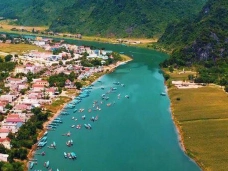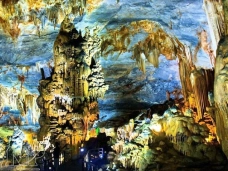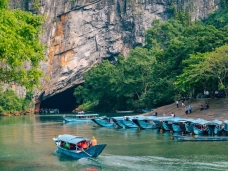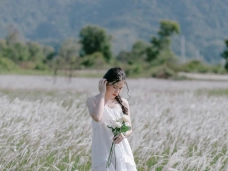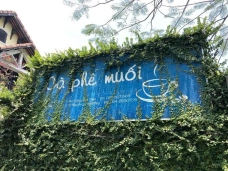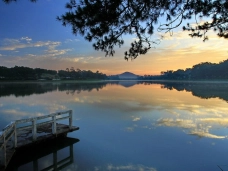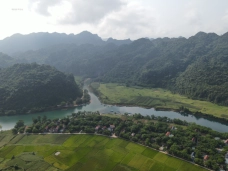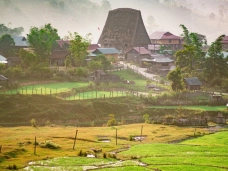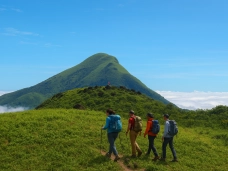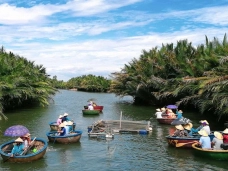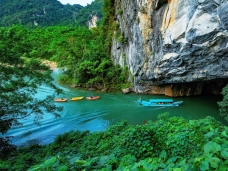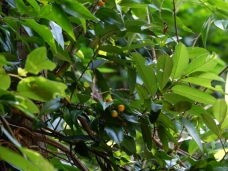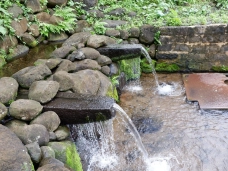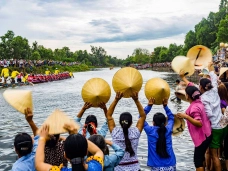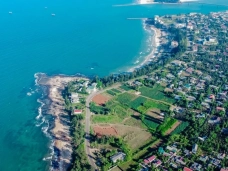From Tân Trào to Định Hóa – A Journey to the Lifeline of a Nation
29-03-2025 10:51
Main contents
In the Silence of the Forest, Time Echoes Softly
The road to Định Hóa winds along the mountainside like a slender thread connecting present and past. Each bend, each climb is a step closer to an era of resistance and glory. The scenery shifts dramatically—from bustling urbanity to the solemn stillness of the midlands, where clouds drift lazily over mountain peaks and the jungle stretches endlessly into the horizon.
Our first stop is Khuôn Tát—the humble residence and workplace of President Hồ Chí Minh. This tiny stilt house remains a silent witness to history. As we continued our walk along a forest path to Khau Tý Hill, where Uncle Hồ resided during his early days in the Việt Bắc resistance base, the air remained crisp, and the trees lush. An old well still held crystal-clear water. The guide whispered: “Here, Uncle Hồ would often walk around the garden, pondering the affairs of the nation.” A passing remark, yet it stirred deep reflection.
In the afternoon, we visited Hang Bòng—the wartime headquarters of the Ministry of Defence. The cave entrance was cold and damp, but deep inside, critical strategic decisions were once made under the harshest of conditions. It’s humbling to imagine that such monumental choices—those that would change the fate of a people—were shaped in such modest, challenging surroundings.

Reading History with Our Feet—and Our Hearts
At the Định Hóa ATK Museum, we were immersed in a collection of invaluable relics. An old oil lamp, a rusted rifle, a hand-drawn map—each a vibrant fragment of the past. They do more than illustrate history; they help you feel it, deeply and intimately.
At noon, we set off from Định Hóa to Tân Trào—a short journey in distance, but one laden with meaning. The road meandered through primeval forests and past humble stilt houses dotting narrow rice fields. We stopped beneath the famed Tân Trào banyan tree—its vast canopy still stands tall, just as it did when General Võ Nguyên Giáp read the order to rise in revolution in 1945. Looking up into its shade, I thought: perhaps it was under this very canopy that the roots of an entire revolution found protection.
Nearby is the Nà Lừa hut, where President Hồ Chí Minh lived and worked from May to August 1945. Thatched with palm leaves and walled with simple bamboo, the hut remains cool and serene. Amidst the forest stillness, the sound of birdsong and rustling leaves seemed to carry the breath of history. It was here that he penned the call for a general uprising—ushering in a new era for Vietnam.

Tân Trào – Where Independence Took Root
We left Định Hóa in the crisp morning air, soft sunlight bathing the forest in gold. Tân Trào emerged like a long-lost chapter reopened in nature’s quiet library. The road here isn’t long, but every step feels like a return to the very pulse of history.
Our first stop of the day was the Nà Lừa hut, where President Hồ lived during those tense pre-uprising months. The hut lies nestled under ancient forest trees, the wind whistling through bamboo walls, birds chirping high above—its tranquillity indescribable. It was here that he wrote to the people, issued the order for uprising, and prepared for the birth of the Democratic Republic of Vietnam. From this hut came the now-famous lines of verse:
Morning by the stream, evening in the cave,
Boiled cassava and bamboo shoots always suffice.
On a rock slab, the Party's history was penned—
This revolutionary life is a noble life indeed.
Just four lines, yet they resonate deeply. Simple, but filled with strength and idealism. The “nobility” mentioned here lies not in material wealth, but in unwavering conviction and dedication to the nation.
From the hut, we continued to the Tân Trào Communal House, where the National People’s Congress was convened on 16 August 1945. The ancient banyan tree in front of the house still stands, its roots clinging to the earth like firm hands. Beneath its branches, the order for the uprising once rang out. I stood silently beneath its leaves, feeling the echo of revolutionary footsteps reverberating through time.

Back to the Present, Carrying the Past
As twilight fell, we returned to a Tày village in Định Hóa, gathered around a meal of sticky rice, wild vegetables, and smoked meat. In the warmth of stilt houses, the soft strumming of the tính lute and gentle then songs filled the air. Here, people are closer to one another. And somehow, the soul feels lighter. Not because the past is distant, but because it still lingers—within every thatched roof, every stone step, every story told with reverence.
This journey to the ATK of Định Hóa and Tân Trào was more than a return to history. It was a return to ourselves. We were reminded of the place that once sustained the very lifeblood of a nation. We grew quiet—not out of solemnity, but of understanding. History is not to be memorised. It is to be lived with, to move forward with. And to know that sometimes, the simplest things are the most sacred.
TM
Comments
Comments (Total 0)
Related Articles
13-12-2025
Giải mã tên gọi Phong Nha – Kẻ Bàng
26-11-2025
Khe Sanh – A Journey into Memory
05-11-2025
8 Unmissable Instagram Spots in Da Lat
28-10-2025





